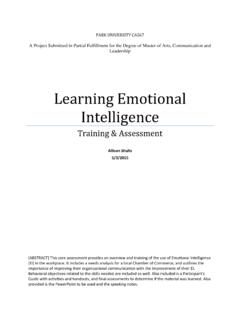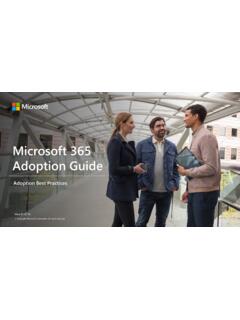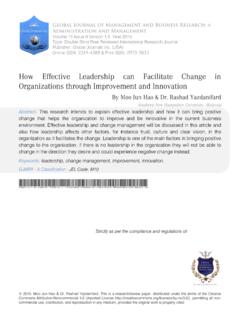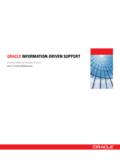Transcription of THE DEFINITIVE GUIDE TO DATA CLASSIFICATION
1 1 THE DEFINITIVE GUIDE TO DATA CLASSIFICATIONTHE DEFINITIVE GUIDE TO DATA CLASSIFICATIONDATA CLASSIFICATION FOR DATA PROTECTION SUCCESS2 THE DEFINITIVE GUIDE TO DATA CLASSIFICATION03 Introduction04 Part One: What is Data CLASSIFICATION ?06 Part Two: Data CLASSIFICATION Myths08 Part Three: Why Data CLASSIFICATION is Foundational12 Part Four: The Resurgence of Data Classification16 Part Five: How Do You Want to Classify Your Data19 Part Six: Selling Data CLASSIFICATION to the Business 24 Part Seven: Getting Successful with Data Classification31 Part Eight: Digital Guardian Next Generation Data CLASSIFICATION & Protection TABLE OF CONTENTS3 INTRODUCTIONTHERE ARE TWO TYPES OF COMPANIES: THOSE THAT RUN ON DATA AND THOSE THAT WILL RUN ON DATA InfoSec professionals will perennially be challenged with more to do than time, budget, and staffing will allow.
2 The most effective method to address this is through prioritization, and in the case of your growing data, prioritization comes from data CLASSIFICATION . In this GUIDE you will learn what CLASSIFICATION is, why it is important, even foundational to data security, and much YOU GO to data CLASSIFICATION Part One: What is Data ClassificationLearning how data CLASSIFICATION drives your data security strategy Part Three: Why Data CLASSIFICATION is FoundationalTrying to understand the different CLASSIFICATION Part Five: How Do You Want to Classify Your DataIn need of speaking points for building internal support Part Six.
3 Selling Data CLASSIFICATION to the BusinessWHY READ THIS GUIDE ?HOW TO USE THIS GUIDETHE DEFINITIVE GUIDE TO DATA CLASSIFICATION4 PART ONEWHAT IS DATA CLASSIFICATION ?5 PART ONE: WHAT IS DATA CLASSIFICATION ?DATA CLASSIFICATIONWHAT: Data CLASSIFICATION is a process of consistently categorizing data based on specific and pre-defined criteria so that this data can be efficiently and effectively protected. WHY: CLASSIFICATION can be driven by governance, company compliance, regulation (PCI, HIPAA, and GDPR), protection of intellectual property (IP), or perhaps most importantly, by the need to simplify your security strategy (more about that later). HOW: There are a few key questions organizations need to ask to help define CLASSIFICATION buckets. Answering these will GUIDE your data CLASSIFICATION efforts and get the program started.
4 What are the data types? (Structured vs Unstructured) What data needs to be classified? Where is my sensitive data? What are some examples of CLASSIFICATION levels? How can data be protected and which controls should be used? Who is accessing my data?BEFORE YOU CAN CLASSIFYData discovery is closely aligned with CLASSIFICATION ; before you can classify data you have to find it though. Data discovery needs to look at the endpoint, on network shares, in databases, and in the cloud. CONFIDENTIALDATATHE DEFINITIVE GUIDE TO DATA CLASSIFICATION6 PART TWODATA CLASSIFICATION MYTHS7 PART TWO: DATA CLASSIFICATION MYTHS3 MYTHS OF DATA CLASSIFICATIONMYTH 1: LONG TIME TO CLASSIFICATION drives insights from day one. Automation for both context and content brings order to all your sensitive data; quickly and collection and visibility can continue until the organization is prepared to deploy and operationalize a policy.
5 Even without a policy, insights from automated data CLASSIFICATION can drive security 2: IT'S TOO data CLASSIFICATION projects get bogged downbecause of overly complex CLASSIFICATION schemes. When it comes to CLASSIFICATION more is not better; moreis just more complex. PricewatershouseCoopers recommends starting with just three categories. Starting with three can dramatically simplify getting your program off the ground. If after deployment more are needed your decision will be driven by data, not 3: IT'S ANOTHER LEVEL OF BUREAUCRACY. Data CLASSIFICATION can be an enabler and a way to simplify data protection. By understanding what portion of your data is sensitive, resources are allocated appropriately. Everyone understands what needs to be protected. Sensitive and regulated data is prioritized; public data is given lower priority, or destroyed, to eliminate future risk to its DEFINITIVE GUIDE TO DATA CLASSIFICATION8 PART THREEWHY DATA CLASSIFICATION IS FOUNDATIONAL9 PART THREE: WHY DATA CLASSIFICATION IS FOUNDATIONALIT'S EASIER TO MANAGE THE DATA DELUGE WITH CLASSIFICATIONO rganizations generate volumes of data.
6 This comes as no surprise but what might be surprising is the accelerating volume at which the data is being created. As an InfoSec professional responsible for protecting digital data, you re going to need a new approach to stay ahead of the data deluge. CLASSIFICATION enables you to: Avoid taking a "one size fits all" approach (inefficient!) Avoid arbitrarily choosing what data to expend resources protecting (risky!).Yr. 0Yr. 1Yr. 2 IDC estimates that the digital universe is growingat ~40% year over year.(source: The Digital Universe of Opportunities, IDC, April, 2014, Vernon Turner)10 PART THREE: WHY DATA CLASSIFICATION IS FOUNDATIONALWHY GARTNER THINKS DATA CLASSIFICATION IS FOUNDATIONALDOCUMENT THE CROWN JEWELS OF THE ORGANIZATION Identify your organization's crown jewels information and services that are critical to meeting strategic business objectives and tailor technical and procedural controls to balance protection and business operating realities.
7 FOCUS ON FOUNDATIONAL CONTROLS Focus on controls that broadly address the problem, such as implementing people-centric security and data CLASSIFICATION . These controls are the foundation upon whichadditional controls can be built. USE DATA CLASSIFICATION AS AN ENABLER In effect, data CLASSIFICATION enables a less restricted handling of most data by bringing clarity to the items requiring the elevated control. (source: Understanding Insider Threats Published: May 2, 2016, Erik T. Heidt, Anton Chuvakin)11 PART THREE: WHY DATA CLASSIFICATION IS FOUNDATIONALWHY FORRESTER THINKS IT'S FOUNDATIONALSTART FROM DATA CLASSIFICATION Security & Risk professionals must start from data CLASSIFICATION to build their data protection strategy. UNDERSTANDING AND KNOWING YOUR DATA IS THE FOUNDATION For many S&R pros, data security initiatives quickly zoom in on controlling access to data or encrypting data.
8 But many overlook that understanding and knowing your data is the foundation for both data security and IF YOU DON'T KNOW WHAT YOU HAVE, YOU CAN'T PROTECT IT If you don t know what you have [data], where it is, and why you have it, you can t expect to apply the appropriate policies and controls to protect it. (source: Rethinking Data Discovery and Data CLASSIFICATION Strategies, Forrester Research Inc., March 25, 2016, Heidi Shey, John Kindervag)THE DEFINITIVE GUIDE TO DATA CLASSIFICATION12 PART FOURTHE RESURGENCE OF DATA CLASSIFICATION13 PART FOUR: THE RESURGENCE OF DATA CLASSIFICATIONCLASSIFICATION HELPS PROTECT AGAINST ALL THREATSThe value to CLASSIFICATION was once limited to protection from insider threats. With the growth in outsider threats, CLASSIFICATION takes on a new importance. It provides the guidance for information security pros to allocate resources towards defending the crown jewels against all actors cause both malicious and unintentional data loss.
9 With a CLASSIFICATION program in place the mistyped email address in a message with sensitive data is flagged. Files that are intentionally being leaked are classified as sensitive and get the attention of security solutions, such as Data Loss Prevention (DLP).External actors seek data that can be monetized. Understanding which data within your organization has the greatest value, and the greatest risk for theft, is where CLASSIFICATION delivers value. By understanding the greater potential impact of an attack on sensitive data, advanced threat detection tools escalate alarms accordingly to allow more immediate FOUR: THE RESURGENCE OF DATA CLASSIFICATIONW ithout ClassificationWith ClassificationCADPERSONAL PICTURESM&AARCHIVED PRESS RELEASEEARNINGS REPORTCADPERSONAL PICTURESM&AARCHIVED PRESS RELEASEEARNINGS REPORTLMHR estrictedInternalPublicBIG DATA IS DRIVING BIG CLASSIFICATION NEEDSSOMEWHERE IN YOUR DATA DELUGE IS.
10 A CAD drawing of the next generation iPhone Personal pictures M&A plans An archived press release announcing your previous acquisition A quarterly earnings report in advance of reporting dateALL GLOBAL DATA IN ZETTABYTES1ZB = 1,126,000,000,000,000,000,000 BYTES 2005200620072008200920102011201220132014 2015201620172018201920200510152025303540 15 PART FOUR: THE RESURGENCE OF DATA CLASSIFICATIONADOPTION MOMENTUM44%of enterprises currently use data CLASSIFICATION as part of their overall information risk are evaluating data CLASSIFICATION with over half that number planning to implement data CLASSIFICATION in the next 18 (source: Forrester's Global Business Technographics Security Survey, Forrester Research Inc., 2015)THE DEFINITIVE GUIDE TO DATA CLASSIFICATION16 PART FIVEHOW DO YOU WANT TO CLASSIFY YOUR DATA?17 PART FIVE: HOW DO YOU WANT TO CLASSIFY YOUR DATADATA CLASSIFICATION METHODSCONTENTUSERCONTEXTC ontent-based CLASSIFICATION inspects and interprets files looking for sensitive information.








